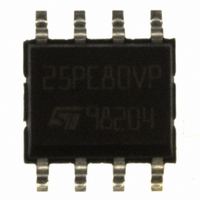M25PE80-VMN6TP NUMONYX, M25PE80-VMN6TP Datasheet - Page 15

M25PE80-VMN6TP
Manufacturer Part Number
M25PE80-VMN6TP
Description
IC FLASH 8MBIT 75MHZ 8SOIC
Manufacturer
NUMONYX
Series
Forté™r
Datasheet
1.M25PE80-VMN6TP.pdf
(66 pages)
Specifications of M25PE80-VMN6TP
Format - Memory
FLASH
Memory Type
FLASH
Memory Size
8M (1M x 8)
Speed
75MHz
Interface
SPI, 3-Wire Serial
Voltage - Supply
2.7 V ~ 3.6 V
Operating Temperature
-40°C ~ 85°C
Package / Case
8-SOIC (3.9mm Width)
Package
8SOIC N
Cell Type
NOR
Density
8 Mb
Architecture
Sectored
Block Organization
Symmetrical
Typical Operating Supply Voltage
3.3 V
Sector Size
256Byte x 4096
Timing Type
Synchronous
Interface Type
Serial-SPI
Lead Free Status / RoHS Status
Lead free / RoHS Compliant
Other names
M25PE80-VMN6TPTR
Available stocks
Company
Part Number
Manufacturer
Quantity
Price
Company:
Part Number:
M25PE80-VMN6TP
Manufacturer:
ST
Quantity:
6 000
Part Number:
M25PE80-VMN6TP
Manufacturer:
ST
Quantity:
20 000
M25PE80
4.8.2
Specific hardware and software protections
The M25PE80 features a hardware protected mode, HPM, and two software protected
modes, SPM1 and SPM2, that can be combined to protect the memory array as required.
They are described below:
HPM
SPM1 and SPM2
HPM in T7Y process (see
The hardware protected mode (HPM) is entered when top sector lock (TSL) is driven
Low, causing the top 256 pages of memory to become read-only. When top sector lock
(TSL) is driven High, the top 256 pages of memory behave like the other pages of
memory and the protection depends on the block protect bits (see SPM2 below).
HPM in T9HX process (see
The hardware protected mode (HPM) is used to write-protect the non-volatile bits of the
status register (that is, the block protect bits, BP2, BP1 and BP0, and the status register
write disable bit, SRWD).
HPM is entered by driving the Write Protect (W) signal Low with the SRWD bit set to
High. This additional protection allows the status register to be hardware-protected.
(see also
The first software protected mode (SPM1) is managed by specific lock registers
assigned to each 64-Kbyte sector.
The lock registers can be read and written using the read lock register (RDLR) and
write to lock register (WRLR) instructions.
In each lock register two bits control the protection of each sector: the write lock bit and
the lock down bit.
–
–
The write lock bit and the lock down bit are volatile and their value is reset to ‘0’ after a
power-down or a reset.
The definition of the lock register bits is given in
registers for the M25PE80 in T7Y
Write lock bit:
The write lock bit determines whether the contents of the sector can be modified
(using the write, program or erase instructions). When the write lock bit is set to ‘1’,
the sector is write protected – any operations that attempt to change the data in
the sector will fail. When the write lock bit is reset to ‘0’, the sector is not write
protected by the lock register, and may be modified.
Lock down bit:
The lock down bit provides a mechanism for protecting software data from simple
hacking and malicious attack. When the lock down bit is set to ‘1’, further
modification to the write lock and lock down bits cannot be performed. A reset, or
power-up, is required before changes to these bits can be made. When the lock
down bit is reset, ‘0’, the write lock and lock down bits can be changed.
Section 6.4.4: SRWD
Important note on page
Important note on page
bit).
process.
Table 11: Not for new design: lock
6):
6):
Operating features
15/66














